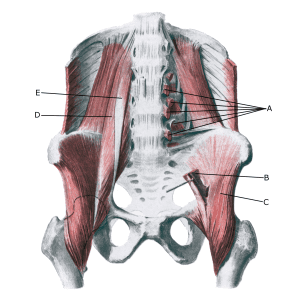Anatomy

C. M. iliacus
D. M. psoas major
E. M. psoas minor
Symptoms
With repetitive strain, the muscle tendon can become ‘inflamed’ (inflamed), swell and, with certain movements, slip over one of the bony prominences at the pelvis or hip joint. When the tendon slips over the bony prominence, the troublesome symptoms are triggered.
Cause
With repetitive strain, the muscle tendon can become ‘inflamed’ (inflamed), swell and, with certain movements, slip over one of the bony prominences at the pelvis or hip joint. When the tendon slips over the bony prominence, the troublesome symptoms are triggered.
There are at least 3 different causes of jumping hips: external (iliotibial tract), internal (iliopsoas tendon) and joint (intra-articular) causes (Musick SR, Varacallo M. 2023).
Examination
In very mild cases with only minimal tenderness, a medical examination may not be required. For more severe pain or lack of progress, a medical examination should be performed to confirm the diagnosis. The diagnosis is usually made during a general medical examination.
If there is any doubt about the diagnosis, dynamic ultrasound scanning can be performed to see the tendon slip at the same time as it triggers the symptoms.
Treatment
Treatment primarily includes relief from pain-inducing activity, stretching and graduated rehabilitation within the pain threshold. If no progress is made despite regular rehabilitation, rehabilitation may be supplemented with medical treatment in the form of arthritis pills (NSAIDs) or ultrasound-guided injection of adrenal cortex hormone. Only in very rare cases is surgical treatment necessary.
Complications
If the progress is not smooth, you should consider whether the diagnosis is correct or if there are complications.
In particular, the following should be considered:
